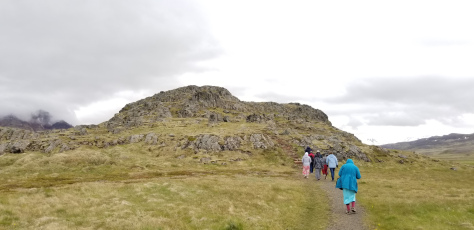Last night was spent in Borgarfjarðarhreppur, which derives its name from Álfaborg, meaning “town of elves.” Ancient legend has it that this part of Iceland is ripe with elves, and there is a fairly substantive hill overlooking this quaint town and welcoming harbour that is purported to be the home of many elves, and in some reports, the home of the Elf Queen.
I have heard a variety of reports on how many Icelanders believe in elves, ranging from 60 to 80 percent. Tales are told of bad luck attending those who mess with elf habitations. There is a sign on the elf hill in Borgarfjarðarhreppur suggesting that those who walk in these environs do well to do so with respect.
Our city tour guide in Reykjavik reported that belief in elves is BS and thought these to be tales told to enforce morals in children, much as has been suggested for the Grimm fairy tales, for instance. On the other hand, our own tour TourMagination guide reported that the good folk in Borgarfjarðarhreppur regularly avoided the shortest route to the nearest village because of a menacing mythical creature on the fjord who pushed more than a few people over the cliff resulting in their demise. Eventually, a strong soul in the 16th century took on this force, and managed to land him, or her, in the drink in order to secure a short, and safe, route for the villagers. A cross was erected to mark the spot and remind folk of the victory won. Insofar as the story represented a hold on the imaginations of the adults, these tales seemed to be more than a tool used by parents to whip their children into shape. Adults, too, were shaped by these tales.
It is not altogether hard to understand why people in these locales held and hold (if the polled reports are to be believed) beliefs in mystical and mythical creatures. The landscape in Iceland, where the earth stretches high and the sky reaches low invites one to imagine, if not see, a meeting of the earthly and heavenly, a kind of world where it is very easy to believe in elves, dwarves, trolls, etc. What cannot be seen is believed because the unimaginable is happening before your very eyes: clouds are swallowing mountains, and the seas are fingering their way into the land. Borders are being pierced everywhere, and souls not piloted by hard, cold reason alone might imagine that things are more complicated than they first appear.
Perhaps, then, there is a place (or places) between “BS” and “literally true.” Perhaps this hankering after mythical creatures is a symbol, or sign, of human hungering for some permeability of boundaries between the earthly and the spiritual; or perhaps more accurately, these tales are symbolic representations of peoples’ experiences of the earthly/heavenly becoming porous. Within Christianity, for instance, the message of the birth of God as the infant Jesus is precisely this: earth being touched by heaven, and the fervent hope of believers in this religion – and some others too – is that there is more to life than meets the eye; for some this “more” is experienced. Perhaps behind these tales that we wink at, exists a deep human hope for and foretaste of a kind of homecoming that abides, eternally.



